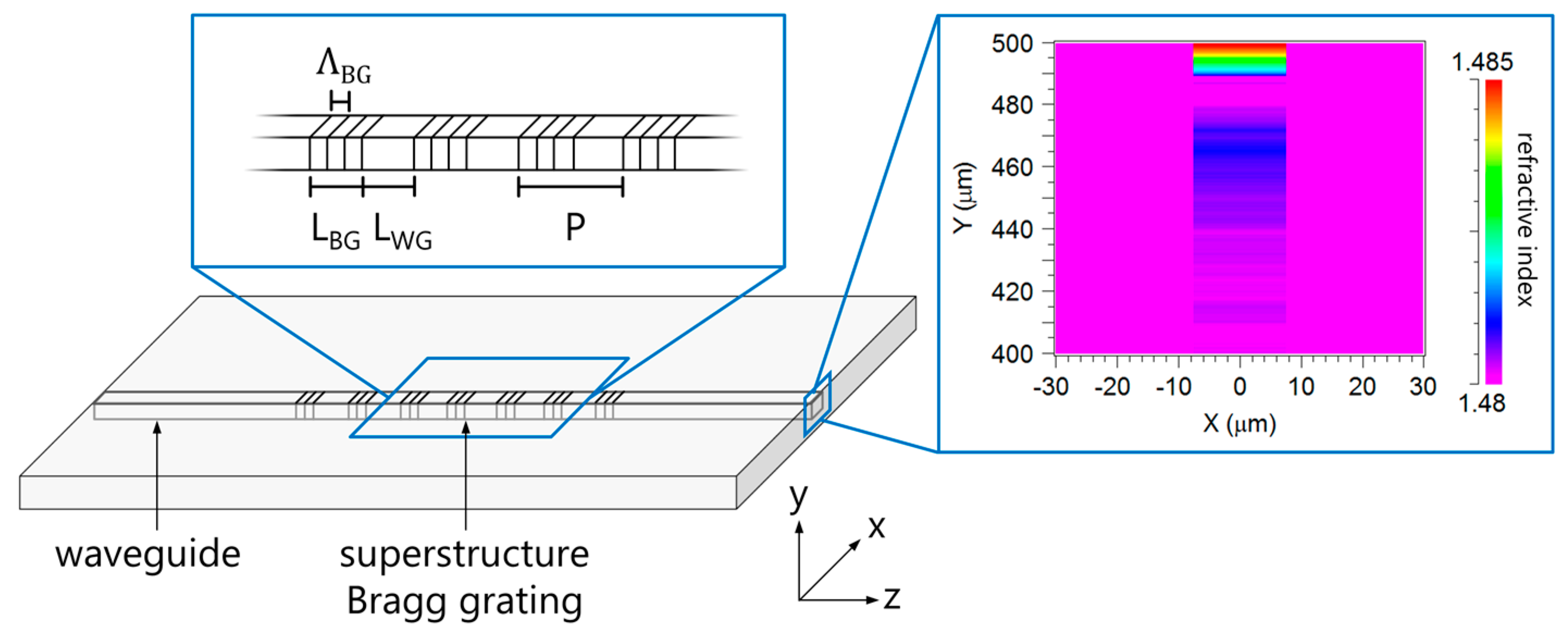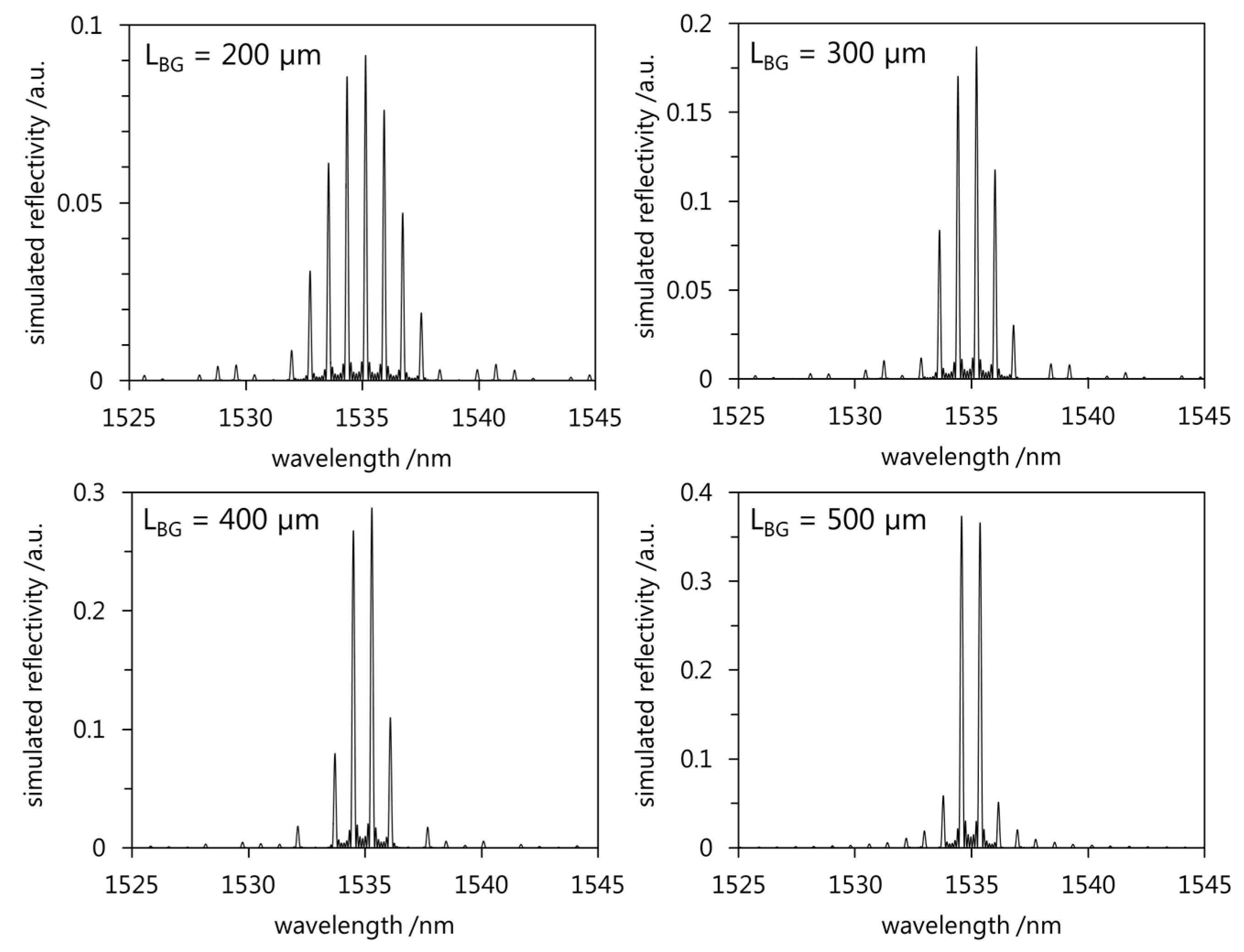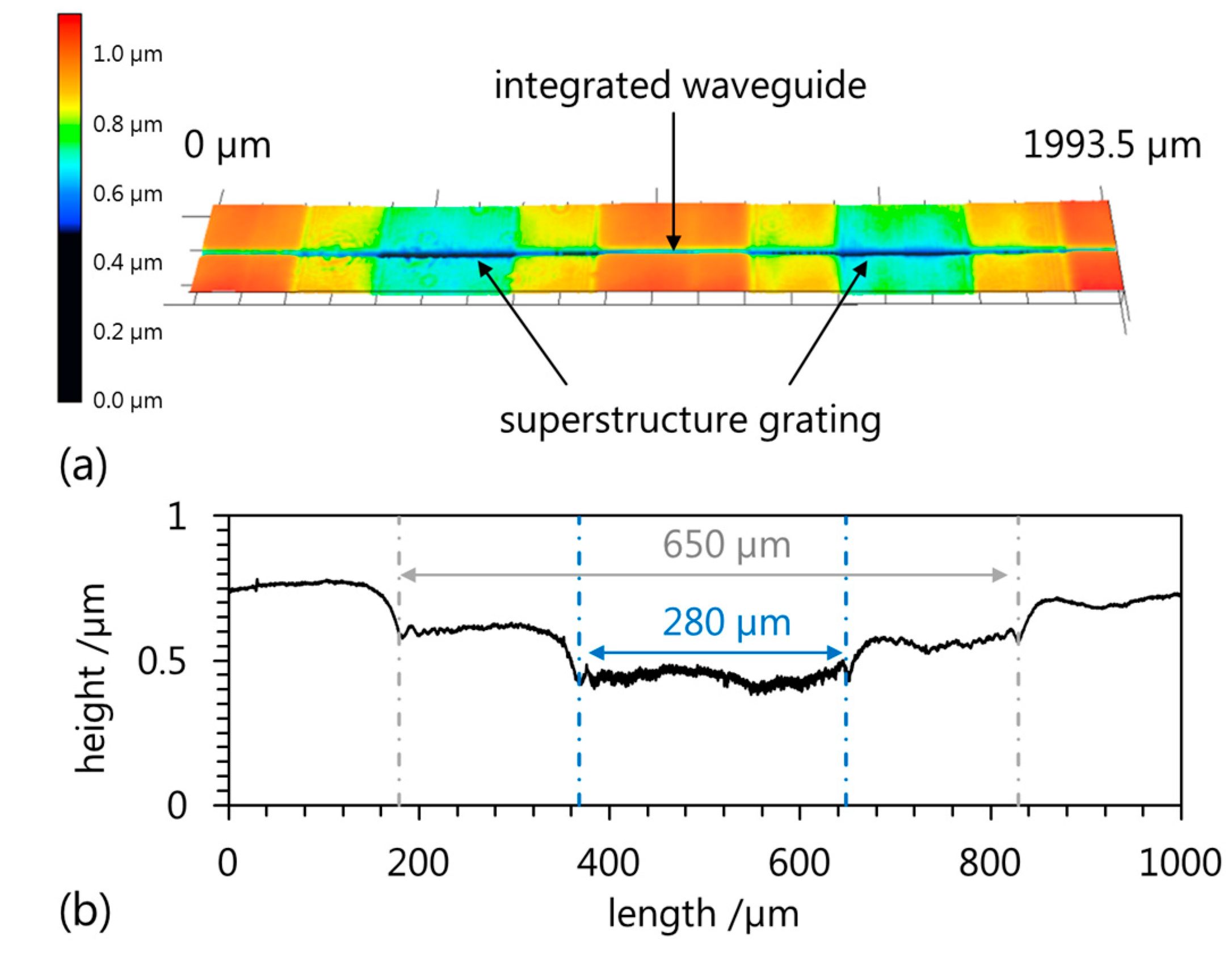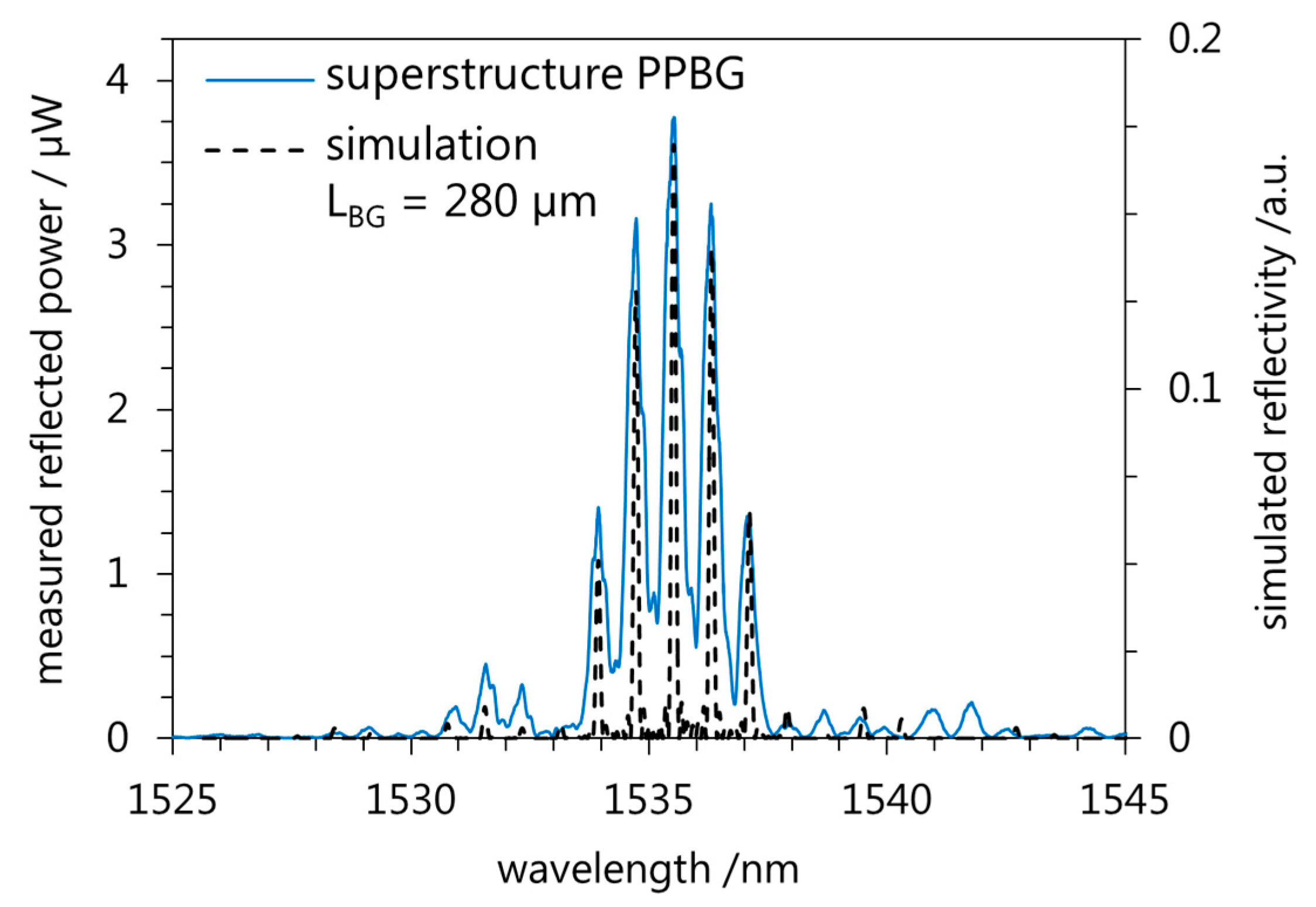UV-Writing of a Superstructure Waveguide Bragg Grating in a Planar Polymer Substrate
Abstract
:1. Introduction
2. Simulation and Fabrication
2.1. Simulation
2.2. Fabrication Process
3. Results and Discussion
4. Conclusions
Author Contributions
Conflicts of Interest
References
- Zhang, Q.; Brown, D.; Reinhart, L.; Morse, T.F.; Wang, J.Q.; Xiao, G. Tuning Bragg wavelength by writing gratings on prestrained fibers. IEEE Photonics Technol. Lett. 1994, 6, 839–841. [Google Scholar] [CrossRef]
- Othonos, A.; Lee, X.; Measures, R.M. Superimposed multiple Bragg gratings. Electron. Lett. 1994, 30, 1972–1974. [Google Scholar] [CrossRef]
- Arigiris, A.; Konstantaki, M.; Ikiades, A.; Chronis, D.; Florias, P.; Kallimani, K.; Pagiatakis, G. Fabrication of high-reflectivity superimposed multiple-fiber Bragg gratings with unequal wavelength spacing. Opt. Lett. 2002, 27, 1306–1308. [Google Scholar] [CrossRef] [PubMed]
- Álvarez-Tamayo, R.I.; Durán-Sánchez, M.; Pottiez, O.; Ibarra-Escamilla, B.; Cruz, J.L.; Andrés, M.V.; Kuzin, E.A. A dual-wavelength tunable laser with superimposed fiber Bragg gratings. Laser Phys. 2013, 23, 55104. [Google Scholar] [CrossRef]
- Xu, M.G.; Archambault, J.L.; Reekie, L.; Dakin, J.P. Discrimination between strain and temperature effects using dual-wavelength fibre grating sensors. Electron. Lett. 1994, 30, 1085–1087. [Google Scholar] [CrossRef]
- Ibsen, M.; Hübner, J.; Pedersen, J.; Kromann, R.; Andersen, L.-U.A.; Kristensen, M. 30 dB sampled gratings in germanosilicate planar waveguides. Electron. Lett. 1996, 32, 2233–2235. [Google Scholar] [CrossRef]
- Hubner, J.; Zauner, D.; Kristensen, M. Strong sampled Bragg gratings for WDM applications. IEEE Photonics Technol. Lett. 1998, 10, 552–554. [Google Scholar] [CrossRef]
- Sparrow, I.J.G.; Smith, P.G.R.; Emmerson, G.D.; Watts, S.P.; Riziotis, C. Planar Bragg grating sensors—Fabrication and applications: A review. J. Sens. 2009, 2009, 607647. [Google Scholar] [CrossRef]
- Binfeng, Y.; Guohua, H.; Ruohu, Z.; Juan, Z.; Yiping, C. Low cost polymer sampled waveguide Bragg grating fabricated by using contact lithography. Opt. Commun. 2015, 354, 89–93. [Google Scholar] [CrossRef]
- Ma, H.; Jen, A.K.-Y.; Dalton, L.R. Polymer-based optical waveguides: Materials, processing, and devices. Adv. Mater. 2002, 14, 1339–1365. [Google Scholar] [CrossRef]
- Tomlinson, W.J.; Kaminow, I.P.; Chandross, E.A.; Fork, R.L.; Silfvast, W.T. Photoinduced refractive index increase in Poly(methylmethacrylate) and its applications. Appl. Phys. Lett. 1970, 16, 486–489. [Google Scholar] [CrossRef]
- Rosenberger, M.; Hessler, S.; Belle, S.; Schmauss, B.; Hellmann, R. Fabrication and characterization of planar Bragg gratings in TOPAS polymer substrates. Sens. Actuators A 2015, 221, 148–153. [Google Scholar] [CrossRef]
- Rosenberger, M.; Hartlaub, N.; Koller, G.; Belle, S.; Schmauss, B.; Hellmann, R. Polymer planar Bragg grating for sensing applications. In Proceedings of the SPIE; Baldini, F., Homola, J., Lieberman, R.A., Eds.; SPIE: Bellingham, WA, USA, 2013; p. 87741P. [Google Scholar]
- Rosenberger, M.; Hessler, S.; Belle, S.; Schmauss, B.; Hellmann, R. Compressive and tensile strain sensing using a polymer planar Bragg grating. Opt. Express 2014, 22, 5483–5490. [Google Scholar] [CrossRef] [PubMed]
- Rosenberger, M.; Eisenbeil, W.; Schmauss, B.; Hellmann, R. Simultaneous 2D strain sensing using polymer planar Bragg gratings. Sensors 2015, 15, 4264–4272. [Google Scholar] [CrossRef] [PubMed]
- Hessler, S.; Rosenberger, M.; Belle, S.; Schmauss, B.; Hellmann, R. Influence of chemical polymer composition on integrated waveguide formation induced by excimer laser surface irradiation. Appl. Surf. Sci. 2015, 356, 532–538. [Google Scholar] [CrossRef]
- Liu, D.; Zhang, Z.; Keil, N.; Grote, N. Thermally tunable silicon nitride sampled gratings in polymer. IEEE Photonics Technol. Lett. 2013, 25, 1734–1736. [Google Scholar] [CrossRef]
- Eggleton, B.; Ouellette, F.; Poladian, L.; Krug, P. Long periodic superstructure Bragg gratings in optical fibres. Electron. Lett. 1994, 30, 1620–1622. [Google Scholar] [CrossRef]
- Wochnowski, C. UV-laser-based fabrication of a planar, polymeric Bragg-structure. Opt. Laser Technol. 2009, 41, 734–740. [Google Scholar] [CrossRef]
- Zhang, C.; Zhang, W.; Webb, D.J.; Peng, G.-D. Optical fibre temperature and humidity sensor. Electron. Lett. 2010, 46, 643. [Google Scholar] [CrossRef]
- Yuan, W.; Stefani, A.; Bache, M.; Jacobsen, T.; Rose, B.; Herholdt-Rasmussen, N.; Nielsen, F.K.; Andresen, S.; Sørensen, O.B.; Hansen, K.S.; et al. Improved thermal and strain performance of annealed polymer optical fiber Bragg gratings. Opt. Commun. 2011, 284, 176–182. [Google Scholar] [CrossRef] [Green Version]






© 2017 by the authors. Licensee MDPI, Basel, Switzerland. This article is an open access article distributed under the terms and conditions of the Creative Commons Attribution (CC BY) license (http://creativecommons.org/licenses/by/4.0/).
Share and Cite
Rosenberger, M.; Schmauss, B.; Hellmann, R. UV-Writing of a Superstructure Waveguide Bragg Grating in a Planar Polymer Substrate. Sensors 2017, 17, 1964. https://doi.org/10.3390/s17091964
Rosenberger M, Schmauss B, Hellmann R. UV-Writing of a Superstructure Waveguide Bragg Grating in a Planar Polymer Substrate. Sensors. 2017; 17(9):1964. https://doi.org/10.3390/s17091964
Chicago/Turabian StyleRosenberger, Manuel, Bernhard Schmauss, and Ralf Hellmann. 2017. "UV-Writing of a Superstructure Waveguide Bragg Grating in a Planar Polymer Substrate" Sensors 17, no. 9: 1964. https://doi.org/10.3390/s17091964




